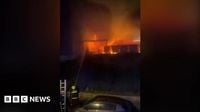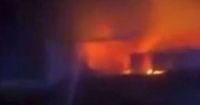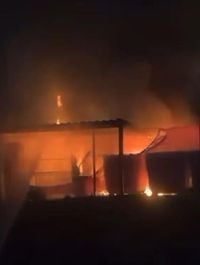On the night of November 12, 2025, the familiar calm of Exeter City’s St James Park was shattered by the sight of flames and the wail of sirens. Just after 10pm, smoke began billowing from a portacabin near the Well Street end of the stadium, quickly drawing attention from nearby residents and passersby. Within moments, what started as a minor electrical fire escalated into an emergency that threatened a vital part of the football club’s matchday infrastructure.
According to Devon and Somerset Fire and Rescue, the fire originated in an electrical consumer unit before spreading to the adjacent portacabin—a temporary building that houses the stadium’s medical and control rooms. As the smoke thickened and flames leapt higher, the first reports reached emergency services at 22:10. Three fire appliances and an aerial ladder platform were immediately dispatched, and as the situation grew more precarious, two additional appliances joined the effort. In total, more than five fire crews responded, working feverishly to contain the blaze.
Firefighters were confronted by a rapidly developing scene. "Fire crews used breathing apparatus and hose reel jets to prevent the fire escalating," a fire service spokesperson told BBC News. The threat was real: flames were “threatening to spread to one of the stands,” specifically the Adam Stansfield stand, which sits at the corner of the away end. Crews had to enter the stand itself, using hydraulic rescue equipment and thermal imaging cameras to check for hotspots and ensure the fire had not crept further into the stadium’s structure.
By midnight, the fire was under control. Ventilation fans were deployed to clear the lingering smoke, and the immediate danger had passed. Miraculously, no injuries were reported—a fact that brought relief to the club’s staff, supporters, and local residents alike. The club’s management was quick to express gratitude. "Thank you to the members of the public who reported the incident and for the fast response of the fire crews who brought the fire under control preventing further damage," a spokesperson for Exeter City Football Club said in a statement quoted by the Daily Mail and National World.
Yet, the aftermath was sobering. The fire had caused significant damage to critical matchday infrastructure. The medical room and control room—both essential for match operations—were badly affected. BBC Radio Devon’s sports presenter James Vickery, reporting from the scene, described the visible damage: "You can see the damage and the charring of the Adam Stansfield stand—at one point firefighters were concerned it was spreading into the stand. The medical room, which is next to the big scoreboard at Exeter JCP, is severely damaged as is the control room. These are really important bits of matchday kit. You can't run a football match without a medical room and also a control room as well."
Club manager Clive Harrison echoed these concerns, telling BBC News that the main issues now revolved around the stadium’s cabling. "The issues we may have are largely around the cabling because the cabling is on the outside of the building and some of that has been damaged by the fire. There's a lot of electrical work to have a look at. Structurally it's not too bad. There's a lot of twisted metal maybe but it's more the cabling to the control room that's important to us now."
One unexpected consequence of the fire was the activation of the stadium’s evacuation alarm system. Due to the damaged cabling, the alarm could not be silenced, leading to a sleepless night for some local residents. "I guess there was a number of residents who didn't get much sleep last night and we apologise for that," Harrison remarked. The club’s immediate priority, he emphasized, was to restore the control room ahead of the next scheduled home match.
The fire service’s technical report, as cited by National World, confirmed that 60% of the portacabin was damaged by fire, along with electrical cupboards and intake equipment. Fire crews utilized six sets of breathing apparatus, three hose reel jets, one safety jet, hydraulic rescue equipment, two positive pressure ventilation fans, and three thermal imaging cameras in their response. The fire was fully extinguished by midnight, but the investigation into its cause was set to continue into daylight hours on November 13.
Despite the considerable damage, the club was fortunate in its timing. Exeter City’s next fixture was an away game, sparing the club the logistical nightmare of trying to host a match without functioning medical or control rooms. The next home game, a lunchtime kickoff against Burton Albion, was scheduled for November 22, giving the club just over a week to repair or replace the damaged facilities. As Vickery noted, "Thankfully Exeter have away game on Saturday because if it was at home it wouldn't have been able to go ahead. That's a really key part of matchday infrastructure. It has been badly damaged by this fire."
For many supporters, the incident was a stark reminder of the importance of stadium safety and the hidden infrastructure that makes matchdays possible. St James Park, which underwent a £3.4 million redevelopment and now boasts a capacity of 8,219, has long been a focal point for the Exeter community. Its history is rich, with a record attendance of 20,984 set back in 1931 during an FA Cup replay against Sunderland. Yet, as this fire demonstrated, even modern facilities are vulnerable to unexpected hazards.
In the wake of the fire, the club moved swiftly to reassure fans and stakeholders. "We will be assessing the damage today and will update when we have more information," the club stated. The cause of the fire remains under investigation, with both the club and the fire service committed to uncovering exactly what went wrong and how similar incidents might be prevented in the future.
As the investigation continues, the focus turns to recovery and resilience. Exeter City’s response—swift, transparent, and community-minded—has drawn praise from both local authorities and supporters. The club’s thanks to the fire crews and the public were heartfelt, and efforts are now underway to ensure that St James Park will be ready to welcome fans back safely for the next home fixture.
Stadium fires are, thankfully, rare events in modern British football, but when they do occur, they highlight the delicate balance between tradition, community, and safety. For Exeter City, this incident will be remembered not for tragedy, but for the professionalism of the response and the resolve to rebuild stronger than before.


